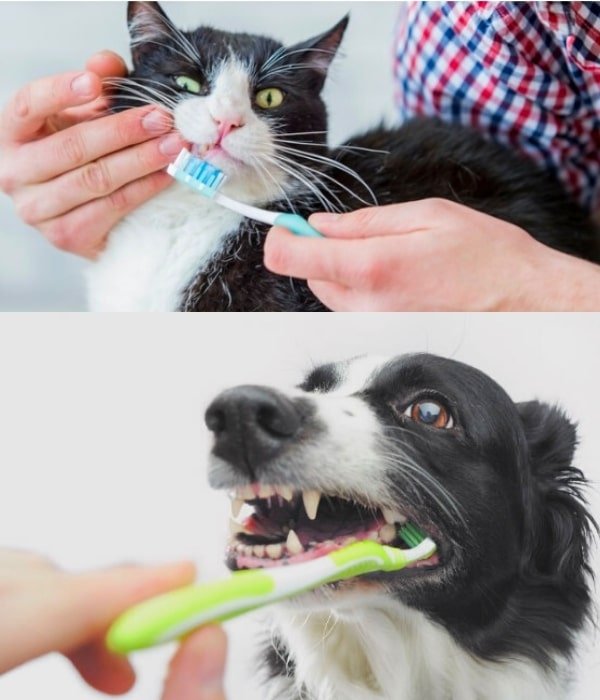
Plan to introduce teeth brushing to your pet
Day 1: Introduce the animal to having its mouth touched. Gently pat or stroke the pet while scratching the muzzle. Slowly lift the lip for 30 seconds. Praise or reward your pet at end of each session.
Day 2: Gently pat or stroke the pet while scratching the muzzle. Slowly lift the lip for 45 seconds. Gently run one finger covered in a wet swab over the pets’ teeth. Then praise or reward your pet at end of the session.
Day 3 & 4: Repeat the steps above increasing the time by 15 seconds.
Day 5: Assess your pet’s response to the previous steps. If your pet is not responding well, continue for a few more days. If your pet is responding well, then proceed by running your finger over the pet’s teeth for 30 seconds and then introduce a wet toothbrush with a small amount of pleasantly flavored paste (poultry flavor is usually well tolerated by most animals). The toothbrush bristles should be placed at a 45° angle to the gum margin where the teeth and gums meet. The movement should be in an oval pattern. Only sufficient pressure should be applied to gently bend the bristles.
Day 6: Repeat the steps above increasing time by 30 seconds
Day 7: Repeat the steps above and put the paste between the bristles, as this will allow the paste the most time next to the teeth
Day 8: Repeat the steps above; gradually increasing the time until 60 seconds is spent on each quadrant including the backs of the teeth.
Treats and Chews
Although not the most effective dental disease preventative measure, many owners find the easiest form of home dental care is by providing pets with treats and chews. These are hard products requiring a large amount of chewing. Care should be taken with the addition of chews to the diet, as pet owners will sometimes not consider the extra calories they will provide. Diets should be adjusted accordingly. To choose an appropriate chew toy for the pet, it should be soft enough to ‘give’ when you attempt to bend it, or an indentation appears when pressing your fingernail into it. Chews that are too hard will easily fracture teeth.
Oral Rinse
Oral rinses can be used in conjunction with brushing or as an alternative if the pet is not complying with the attempts to brush. Oral rinses will generally contain chlorhexidine and zinc, along with cetylpyridinium chloride to help fight plaque, maintain oral health and freshen breath. Manufacturer’s instructions should be strictly adhered to when recommending these products.
Toys
Toys are useful additions to a dental hygiene program. Again, these should not be relied on solely. Dental toys encourage chewing and work by the chewing action aiding in the removal of plaque via physical rubbing and the spread of protective saliva. Care should be taken when selecting toys for animals. Very hard toys could lead to broken teeth and you need to ensure that teeth can’t get caught in the toy.
